Welcome to the vibrant world of Peruvian cuisine! If you’re looking for a dish that’s bursting with fresh flavors, incredibly easy to make, and perfect for a warm day or as a stunning appetizer, you’ve come to the right place. This authentic Peruvian Ceviche with Leche de Tigre recipe delivers that quintessential bright, zesty, and slightly spicy kick that makes this dish so beloved. Forget complicated techniques; we’ll guide you through simple steps to create this culinary masterpiece right in your own kitchen. Get ready for a dish that tastes like a vacation on a plate!
In This Post
Why You’ll Love This Peruvian Ceviche with Leche de Tigre
Making Peruvian ceviche might sound intimidating, but it’s surprisingly straightforward. Here’s why this recipe will become your new favorite:
- Incredibly Fresh: The star is high-quality raw fish “cooked” in vibrant citrus juice.
- Quick Prep: Minimal actual cooking time, mostly just chopping and marinating.
- Bursting with Flavor: The “Leche de Tigre” (Tiger’s Milk) marinade is a magical blend of citrus, spice, and aromatics that is utterly addictive.
- Naturally Healthy: Low in fat, high in protein, and packed with fresh vegetables and herbs.
- Impressive Yet Simple: Looks elegant and complex but is remarkably easy to execute, making it perfect for entertaining.
Peruvian Ceviche with Leche de Tigre Ingredients
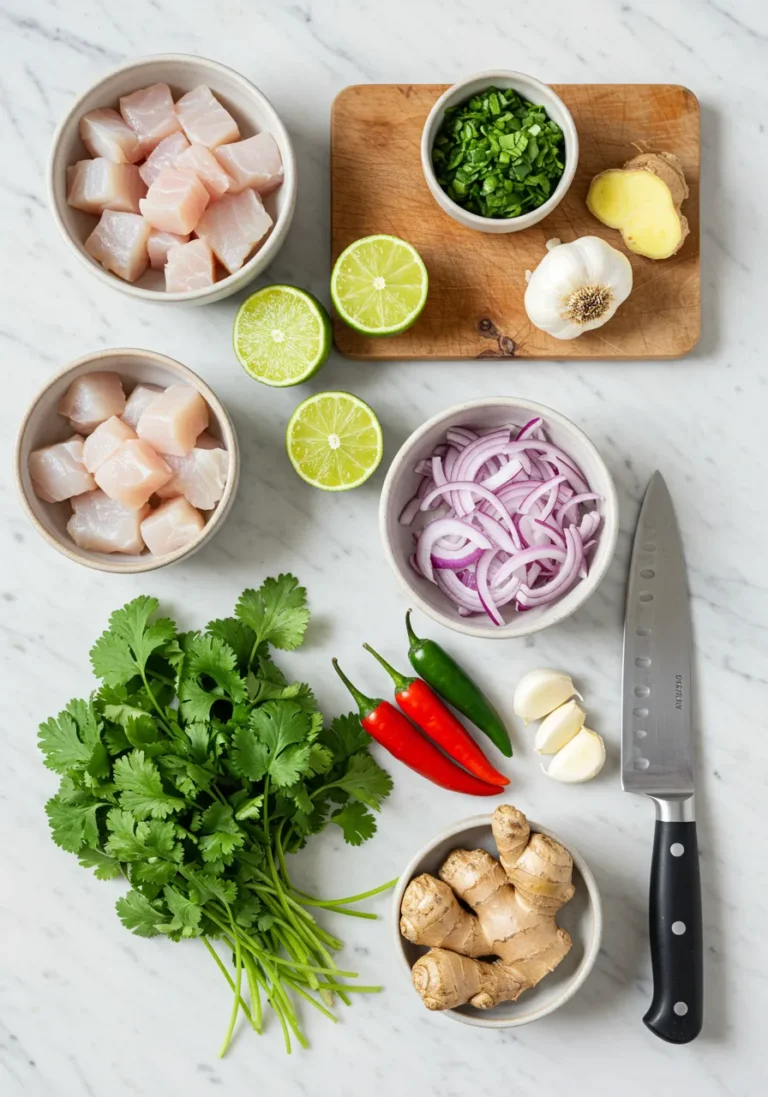
What You’ll Need
Gathering your fresh ingredients is key to perfect ceviche. Here’s what you’ll need:
- 1 pound very fresh, sushi-grade white fish fillets (such as sea bass, snapper, corvina, or sole), cut into 1/2-inch cubes
- 1 medium red onion, thinly sliced
- 1/2 cup fresh lime juice (from about 4-6 limes)
- 1/4 cup fresh lemon juice (from about 1-2 lemons)
- 1-2 ají limo or rocoto peppers, seeded and minced (or use 1 small jalapeño or serrano pepper for less heat)
- 1 clove garlic, minced
- 1 inch piece fresh ginger, peeled and grated
- 2-3 sprigs fresh cilantro, leaves and stems separated
- 1/4 cup fish broth or water (optional, for Leche de Tigre)
- Salt, to taste
- Freshly ground black pepper, to taste
For Serving & Garnish:
- Sweet potato (cooked and sliced)
- Large kernel corn (cooked, such as choclo)
- Toasted corn kernels (cancha)
- Fresh cilantro leaves, chopped
- Lettuce leaves
Smart Swaps & Flavor Boosts
- Fish Swap: While firm white fish is traditional, you can also use very fresh scallops, shrimp (briefly blanched), or even firm tofu (for a vegetarian version). Just adjust marinating times accordingly.
- Citrus Mix: Experiment with grapefruit or orange juice for a slightly sweeter Leche de Tigre, but ensure lime juice is the primary acid.
- Spice Adjustment: Omit the chili pepper entirely, or add more for extra heat. Using red pepper flakes steeped in the Leche de Tigre is another way to add warmth without texture.
- Upgrade: Add a splash of Pisco (Peruvian grape brandy) or good quality vodka to the Leche de Tigre just before serving for a classic Peruvian touch.
Ingredient Notes & Sourcing
- Fish Quality is Paramount: Always use the freshest, highest-quality fish you can find. Talk to your fishmonger and ask for “sushi-grade” fish intended for raw consumption. Freshness is key to both taste and safety. Use the fish the same day you buy it if possible.
- Lime Juice: Always use fresh limes. Bottled juice won’t give you the same vibrant flavor. Roll the limes on the counter before cutting to get more juice.
- Ají Limo/Rocoto: These Peruvian chilies provide authentic flavor and heat. If you can’t find them, a seeded jalapeño or serrano is a good substitute. Handle with gloves!
- Red Onion: Slice the red onion as thinly as possible. Soaking the slices in ice water for 5-10 minutes before adding them can remove some of the harsh bite.
- Cilantro: Don’t discard the cilantro stems! They contain a lot of flavor and are traditionally used in the Leche de Tigre base before straining.
- Sweet Potato & Corn: These traditional accompaniments provide a sweet, starchy contrast to the acidic ceviche. You can find large kernel Peruvian corn (choclo) and toasted cancha corn at Latin American markets.
Essential Equipment
You don’t need fancy gadgets for this Peruvian ceviche recipe. Here’s what will help:
- Sharp Knife: Crucial for clean cuts of fish and thinly slicing onions and peppers. A sharp knife ensures the fish cubes hold their shape.
- Cutting Boards: Separate boards for fish and vegetables are recommended for food safety.
- Large Mixing Bowl: Needed to gently combine the fish and the Leche de Tigre marinade. Choose a non-reactive bowl (glass, ceramic, or stainless steel).
- Fine-Mesh Sieve: Essential for straining the Leche de Tigre after blending to get a smooth liquid.
- Blender or Immersion Blender: While not strictly *essential* (you could mince everything finely), a blender helps emulsify the ingredients for a smooth, flavorful Leche de Tigre. No blender? Finely mince garlic, ginger, and chili, and muddle them with cilantro stems before mixing with citrus juice.
- Serving Dishes: Shallow bowls or coupe glasses work beautifully for presentation.
Crafting Your Peruvian Ceviche with Leche de Tigre: Step-by-Step
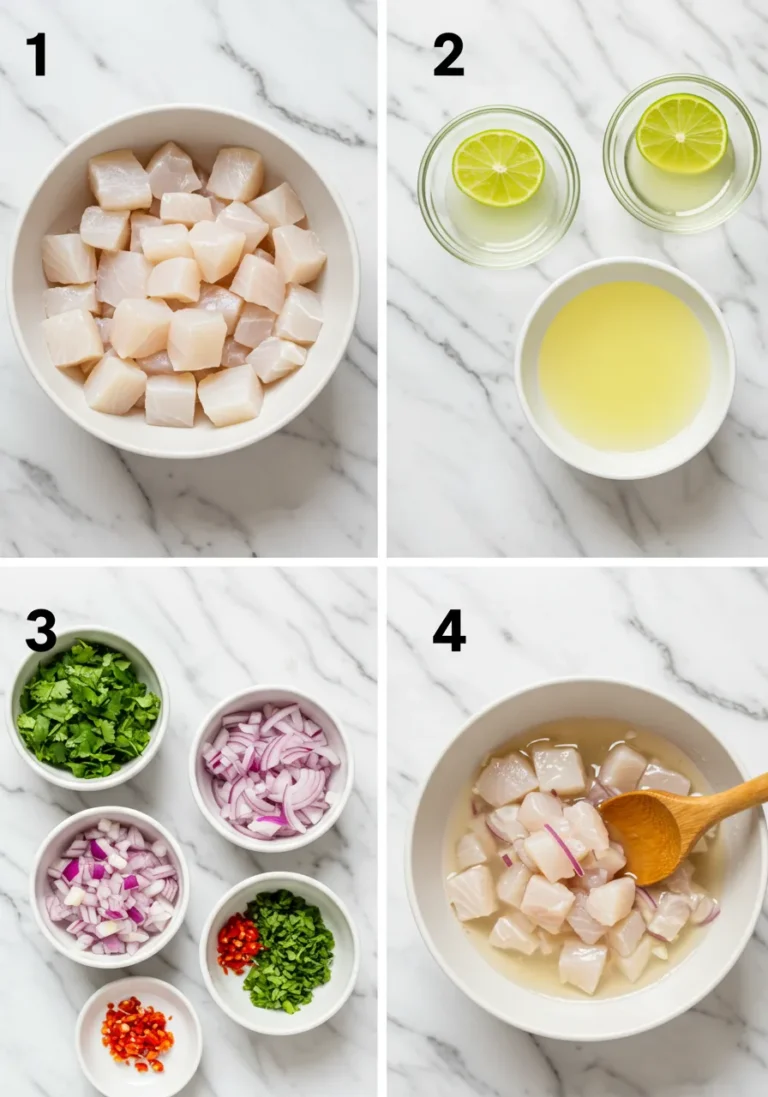
Get ready to transform fresh ingredients into a dazzling dish! This process involves making the flavor base (Leche de Tigre) and then quickly marinating the fish.
Prep time: 20 minutes | Cook time: 15-25 minutes (marinating)
- Prepare the Fish: Ensure your fish is very cold. Pat the fish fillets dry with paper towels. Using a sharp knife, cut the fish into uniform 1/2-inch cubes. Place the cubed fish in your large mixing bowl. Cover and place in the refrigerator while you make the Leche de Tigre. Keep the fish cold at all times until ready to marinate.
- Make the Leche de Tigre Base: In your blender, combine the lime juice, lemon juice, minced chili (ají limo or rocoto/jalapeño), minced garlic, grated ginger, and cilantro stems (if using). Add the optional fish broth or water if you prefer a slightly less intense marinade.
- Blend and Strain: Blend the mixture until smooth. This helps extract maximum flavor from the aromatics. Pass the blended liquid through a fine-mesh sieve into a clean bowl, pressing down on the solids to extract all the liquid. Discard the solids. This strained liquid is your Leche de Tigre marinade. Season the Leche de Tigre with salt and pepper to taste. It should be vibrant, tangy, and slightly spicy.
- Marinate the Fish: Remove the cubed fish from the refrigerator. Add the thinly sliced red onion to the fish. Pour the prepared Leche de Tigre over the fish and onions. Gently stir to ensure all the fish is submerged in the liquid.
- The “Cooking” Begins: Let the fish marinate in the refrigerator for 15 to 25 minutes. The acidity of the citrus juice will denature the protein in the fish, causing it to turn opaque and firm up, similar to cooking with heat. The exact time depends on the thickness of the cubes and your preference – start checking around 15 minutes. The fish should be opaque throughout, not translucent. Do not over-marinate, or the fish can become tough or mushy.
- Taste and Adjust: Once the fish is “cooked,” taste a piece along with some of the Leche de Tigre. Adjust seasoning with more salt or a pinch more chili if needed. The Leche de Tigre should be intensely flavorful.
- Serve Immediately: Spoon the ceviche, along with plenty of the Leche de Tigre marinade, into individual serving bowls or coupe glasses. Garnish with slices of cooked sweet potato, kernels of cooked corn, toasted cancha corn, and chopped fresh cilantro leaves.
Ensuring Perfection: Pro Tips & Troubleshooting
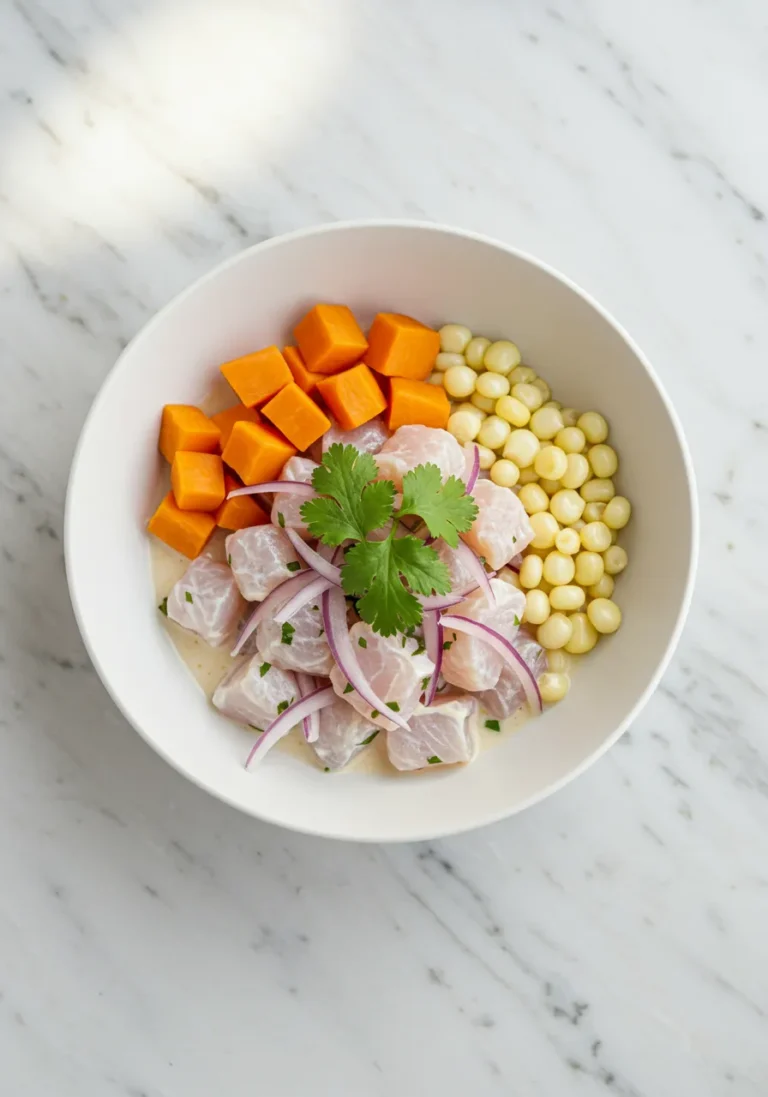
Achieving great ceviche is simple when you follow these tips:
- The Secret to Tender Fish: Use very fresh, sushi-grade fish. Cut the cubes evenly so they “cook” at the same rate. Don’t marinate for too long – 15-25 minutes is usually sufficient for 1/2-inch cubes, resulting in tender, flavorful fish.
- Leche de Tigre Power: Don’t skip blending the aromatics and cilantro stems into the Leche de Tigre base before straining. This step infuses the liquid with maximum flavor.
- Common Pitfalls & How to Sidestep Them:
- Mushy Fish: Usually caused by fish that isn’t fresh enough or marinating for too long. Start with the freshest fish and check the fish’s texture around the 15-minute mark.
- Bland Flavor: Ensure your lime juice is fresh and that you’ve seasoned the Leche de Tigre adequately with salt, pepper, and chili. The marinade should taste intense on its own.
- Tough Onion: Thinly slice the red onion and consider soaking it in ice water for a few minutes beforehand to mellow its bite.
- Prep Efficiency: You can prepare the sweet potato and cook the corn ahead of time. Slice the red onion just before marinating, or soak it while you make the Leche de Tigre. Make the Leche de Tigre base just before adding it to the fish.
- Technique Spotlight: The Acid “Cook”: Understanding that the citric acid in the lime juice denatures the protein in the fish is key. This isn’t cooking in the traditional sense (it doesn’t kill parasites or bacteria), which is why using incredibly fresh, safe-to-eat-raw fish is non-negotiable. The fish changes from translucent to opaque as the acid penetrates.
Variations & Creative Twists
- Spice It Up/Down: Add extra minced chili, a dash of chili paste (like aji amarillo paste), or serve with hot sauce on the side. Reduce or omit chili entirely for a mild version.
- Gourmet Twists: Add diced avocado just before serving for creaminess. Include thinly sliced octopus (pre-cooked and chilled) or blanched shrimp alongside the fish. Top with a drizzle of good quality olive oil or a sprinkle of flaky sea salt.
- Simplify It: Use pre-minced garlic and ginger, but fresh is always best. If you can’t find Peruvian corn, use regular frozen corn kernels (cooked).
- Seasonal Swaps: While not traditional, you could potentially experiment with other high-quality seafood like bay scallops or peeled, deveined shrimp (blanched).
Printable Recipe Card
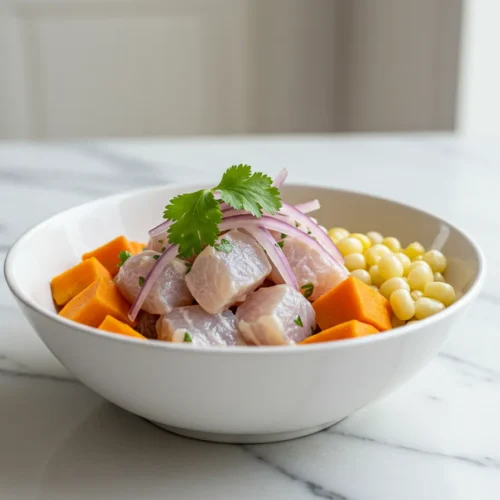
Peruvian Ceviche with Leche de Tigre Recipe
Equipment
- 1 Sharp Knife
- 2 Cutting Boards Separate for fish and vegetables
- 1 Large Mixing Bowl Non-reactive (glass, ceramic, or stainless steel)
- 1 Fine-Mesh Sieve
- 1 Blender or Immersion Blender Optional, for smoother Leche de Tigre
- 4 Serving Dishes Shallow bowls or coupe glasses
Ingredients
- 1 pound Very fresh, sushi-grade white fish fillets such as sea bass, snapper, corvina, or sole, cut into 1/2-inch cubes
- 1 medium Red onion thinly sliced
- 1/2 cup Fresh lime juice from about 4-6 limes
- 1/4 cup Fresh lemon juice from about 1-2 lemons
- 1-2 Ají limo or rocoto peppers seeded and minced (or use 1 small jalapeño or serrano pepper)
- 1 clove Garlic minced
- 1 inch piece Fresh ginger peeled and grated
- 2-3 sprigs Fresh cilantro leaves and stems separated
- 1/4 cup Fish broth or water optional, for Leche de Tigre
- Salt to taste
- Freshly ground black pepper to taste
- Sweet potato cooked and sliced, for serving
- Large kernel corn cooked, such as choclo, for serving
- Toasted corn kernels cancha, for serving
- Fresh cilantro leaves chopped, for garnish
- Lettuce leaves for serving
Instructions
- Ensure your fish is very cold. Pat the fish fillets dry with paper towels. Using a sharp knife, cut the fish into uniform 1/2-inch cubes. Place the cubed fish in your large mixing bowl. Cover and place in the refrigerator while you make the Leche de Tigre. Keep the fish cold at all times until ready to marinate.
- In your blender, combine the lime juice, lemon juice, minced chili (ají limo or rocoto/jalapeño), minced garlic, grated ginger, and cilantro stems (if using). Add the optional fish broth or water if you prefer a slightly less intense marinade.
- Blend the mixture until smooth. This helps extract maximum flavor from the aromatics. Pass the blended liquid through a fine-mesh sieve into a clean bowl, pressing down on the solids to extract all the liquid. Discard the solids. This strained liquid is your Leche de Tigre marinade. Season the Leche de Tigre with salt and pepper to taste. It should be vibrant, tangy, and slightly spicy.
- Remove the cubed fish from the refrigerator. Add the thinly sliced red onion to the fish. Pour the prepared Leche de Tigre over the fish and onions. Gently stir to ensure all the fish is submerged in the liquid.
- Let the fish marinate in the refrigerator for 15 to 25 minutes. The acidity of the citrus juice will denature the protein in the fish, causing it to turn opaque and firm up, similar to cooking with heat. The exact time depends on the thickness of the cubes and your preference – start checking around 15 minutes. The fish should be opaque throughout, not translucent. Do not over-marinate, or the fish can become tough or mushy.
- Once the fish is “cooked,” taste a piece along with some of the Leche de Tigre. Adjust seasoning with more salt or a pinch more chili if needed. The Leche de Tigre should be intensely flavorful.
- Spoon the ceviche, along with plenty of the Leche de Tigre marinade, into individual serving bowls or coupe glasses. Garnish with slices of cooked sweet potato, kernels of cooked corn, toasted cancha corn, and chopped fresh cilantro leaves.
Notes
Serving & Pairing Suggestions
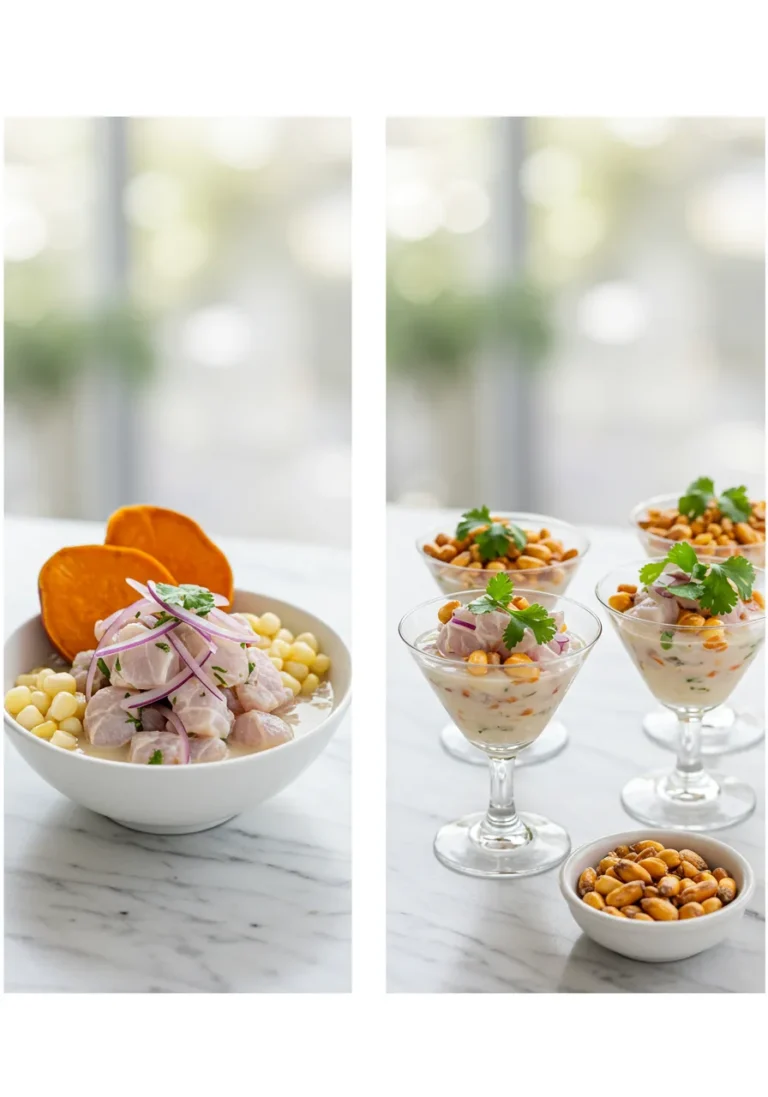
Peruvian ceviche is often served as a refreshing appetizer or a light main course, especially in warm weather. The traditional accompaniments offer a perfect balance:
- Pairings: Serve alongside slices of tender cooked sweet potato (its sweetness contrasts beautifully with the acidity), large kernel corn (choclo), and crispy toasted corn (cancha). A simple leaf of lettuce under the ceviche is traditional.
- Drinks: The classic pairing is a cold beer or a crisp, dry white wine like Sauvignon Blanc or Albariño. For something stronger, a Pisco Sour is a natural fit. Non-alcoholic options include Inca Kola (a Peruvian soda) or a refreshing sparkling water with lime.
- Occasion: Perfect for summer gatherings, backyard BBQs, light lunches, or as an impressive starter for a dinner party.
- Plating Tip: Arrange the sweet potato slices and corn around the edge of the bowl or plate, then spoon the ceviche and Leche de Tigre into the center. Garnish generously with fresh cilantro and a sprinkle of cancha.
Storing Your Peruvian Ceviche
Due to the nature of raw fish marinated in acid, ceviche is best enjoyed immediately after the marinating time is complete (within 15-25 minutes). The citrus continues to “cook” the fish, and storing it for too long will affect the texture, making it tough or mushy, and potentially compromise food safety.
- Optimal Storage: It is not recommended to store finished ceviche for extended periods. It is truly a dish meant to be made and eaten fresh.
- Food Safety Note: Since the fish is not cooked by heat, using extremely fresh, safe-to-eat-raw fish is paramount, and eating it promptly minimizes any risk.
- Signs of Spoilage: Any off smell, slimy texture, or excessive cloudiness in the Leche de Tigre indicates spoilage. Discard immediately.
- Prep Ahead (Components Only): You can prepare some components ahead of time: cook the sweet potato and corn, mince the garlic and ginger, chop the cilantro, and slice the onion (soaking it in ice water in the fridge). Make the Leche de Tigre base just before adding the fish. Cut the fish just before adding the Leche de Tigre. This ensures everything is ready to assemble and marinate right before serving.
- Recipe Remix Idea: While leftover ceviche itself isn’t ideal, any leftover sweet potato and corn can be used in a salad or side dish the next day.
Nutrition Breakdown
Here is an estimated nutritional breakdown per serving of this Peruvian Ceviche (using sea bass, without sweet potato, corn, or cancha):
- Calories: 150-200 kcal
- Protein: 25-30g
- Fat: 3-6g
- Saturated Fat: 1g
- Carbohydrates: 5-10g
- Sugar: 3-5g
- Sodium: 200-400mg (varies based on salt added and fish type)
Disclaimer: Nutrition data is an estimate calculated using online tools and may vary based on specific ingredients used, portion sizes, and preparation methods.
Peruvian Ceviche with Leche de Tigre FAQ
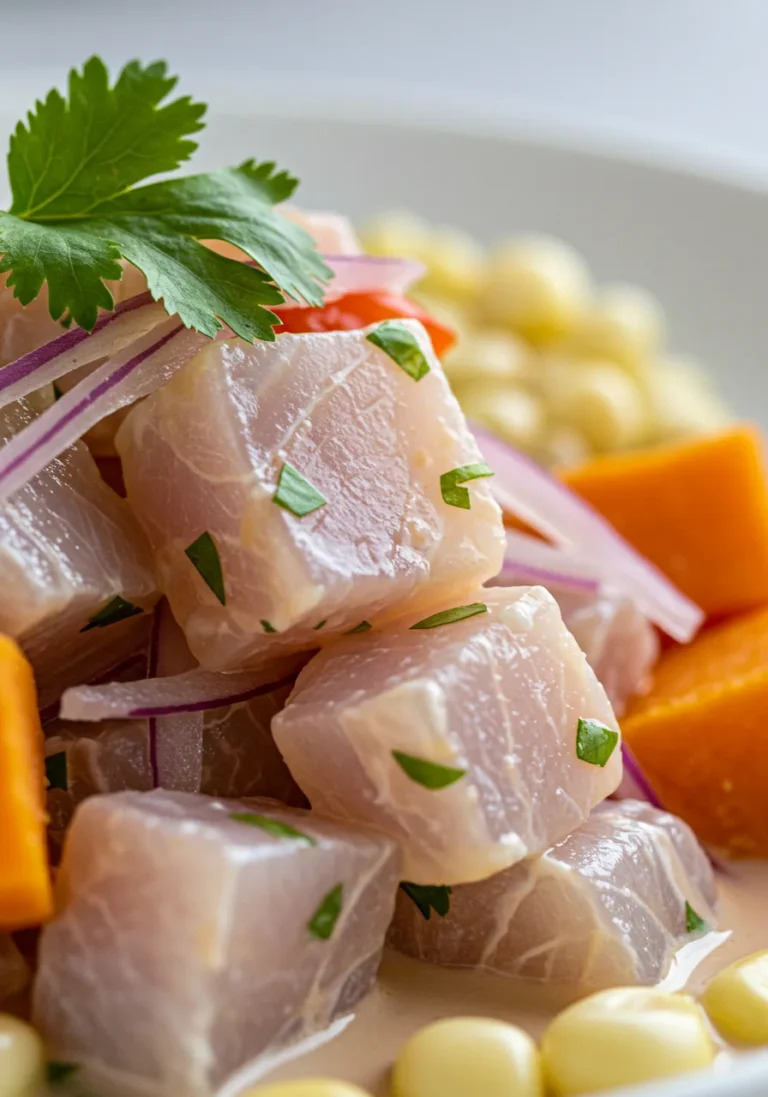
- What kind of fish is best for ceviche? Firm, white-fleshed, mild fish like sea bass, snapper, corvina, sole, or flounder. Make sure it is extremely fresh and labeled “sushi-grade” or suitable for raw consumption.
- How long does the fish need to marinate? For 1/2-inch cubes, typically 15-25 minutes. The fish should turn opaque throughout. Adjust time based on your preference for texture (shorter time = more tender/closer to raw).
- What is Leche de Tigre? Literally “Tiger’s Milk,” it’s the flavorful, acidic marinade made from citrus juice, chili, onion, cilantro, garlic, ginger, and sometimes fish juices or broth. It’s considered an elixir and is often served on its own in a shot glass.
- Can I make ceviche ahead of time? It’s best to marinate the fish just before serving. You can prepare the Leche de Tigre base (excluding the fish) and chop your garnishes a few hours in advance and keep them chilled.
- Is ceviche safe to eat? If made with extremely fresh, high-quality, sushi-grade fish from a reputable source and consumed immediately after marinating, the risk is minimized. However, eating raw fish always carries some inherent risk.
- Why is ceviche served with sweet potato and corn? The sweetness and starch of the sweet potato and corn provide a balancing contrast to the acidity and spice of the ceviche, creating a harmonious bite.
Enjoy Your Creation & Let’s Connect!

There you have it – a taste of Peru right in your own kitchen! This Peruvian Ceviche with Leche de Tigre recipe proves that incredible flavor doesn’t require complicated steps. It’s a testament to the beauty of simple, fresh ingredients handled with care. Enjoy the bright, zesty flavors of this easy and authentic dish. Simple steps for delicious results, every time!
We hope you love making and sharing this recipe as much as we do. If you try it, we’d love to hear how it turned out! Please leave a comment below to share your experience.
You can also share your photos with us on social media! Tag us on Instagram or save it to your boards on Pinterest.
What’s your favorite type of ceviche? Or are you trying ceviche for the first time? Let us know in the comments!





